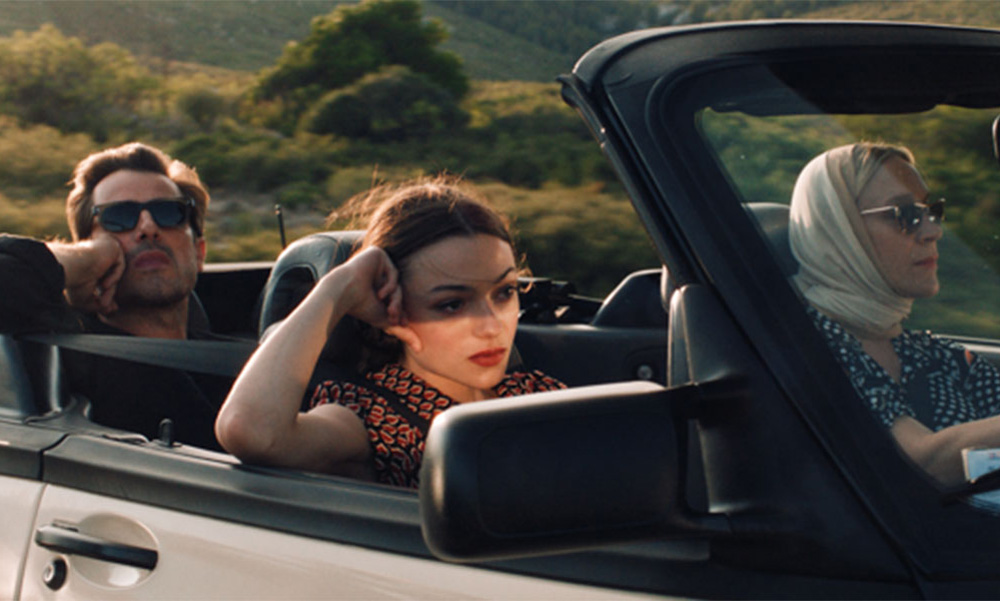“The more things become forced, I lose interest,” Anne (Chloë Sevigny) tells Cecile (Lily McInerny) in “Bonjour Tristesse,” opening up her sketchbook of fashion designs so that that teenager can be held in thrall at first by the elegant dresses on display and perhaps then the ease with which the ideas for them must come. Anne has been a bit of a mythical figure for the teenage Cecile, who knew her as a friend of her late mother but only largely from whatever her father Raymond (Claes Bang) passed along and it may not be obvious to her to see why he felt compelled to invite her to their summer vacation in the south of France when everything seems to be going swimmingly — she’s even starting to warm up to his new girlfriend Elsa (Nailia Harzoune) — but it’s actually a sign of Raymond’s unwillingness to rock the boat too much to attempt to provide a model of confidence for his daughter that he knows he’d be unable to pass along himself without much fanfare.
It was easy to admire Anne in the first screen adaptation of Françoise Sagan’s novel, which Otto Preminger directed not long after the coming-of-age tale became a beloved classic almost immediately upon its release (the “Laura” director’s take on it less so) when she swept into town like an impervious Auntie Mame and could promise the world to Cecile, who was nowhere near as cultured quite yet. But writer/director Durga Bose-Chew shows that the source material was ripe for a juicy reboot when neither Anne or Cecile is idealized as they were in the 1950s, shrewdly redefining the dynamic when the two are given equal power, though Cecile doesn’t have a full understanding of hers just yet.
McInerny, who previously impressed with a balance of poise and naivete in “Palm Trees and Power Lines” as a teen unwittingly lured into the adult industry, is similarly well-cast here, semi-conscious of how to use her youth and beauty to get what she wants, whether it’s from Cyril (Aliocha Schneider), the local beach rat she spends the summer schtupping, or Anne, who she starts thinking about screwing over when she sees no need for a stepmother, preying on Anne’s desire to have her early days back. However, when Cecile can’t be certain of the full effect she can have, “Bonjour Tristesse” is enlivened by what’s going on under the surface during a carefree summer in which no one can relax. Sevigny is an inspired choice when, much like one of her most famous roles in “Big Love,” a steely determination and blasé attitude that has clearly gotten Anne through the world — and became the obvious note to play for the character, but deepens it by making clear how it’s hidden great insecurity, once occupying the role of third wheel in a friendship with Raymond and Cecile’s mother and uneasy with now having anyone lean on her after her hard-won independence.
Still, Anne can’t help but be drawn to the fantasy of what could be when Raymond opens the door to a reunion, and when the film ends up shattering illusions left and right, Chew-Bose shows a considerable gift for crafting images both on the screen and on the page that the characters have fashioned for themselves which can be brutally upended. Working with “Harka” cinematographer Maximilian Pittner, the director creates a beguiling and languorous visual rhythm that’s at odds with the intensity of the emotions stirring inside, an elegance that becomes too intimidating to be disturbed by the messy feelings involved. (Some choice needle drops add to a casual atmosphere where the energy shifts once every move starts to have a certain calculation behind it.)
When Sagan’s novel endures as a page turner in part because of its plotting, Chew-Bose can at times feel obligated to follow the original story when the vibe is what she captures so well, with Cecile’s machinations to make Elsa the apple of her father’s eye again after Annie comes back into the picture slightly clumsy in both their execution on screen and their inclusion in the film. Yet this is a small quibble for an extraordinarily assured drama where Bose-Chew’s ear for natural dialogue, giving the patter between Cecile and Raymond as well as with Anne a real lived-in quality, is matched by an exceptional eye. “Bonjour Tristesse” may catch a moment that all involved would rather put behind them, but it lingers when it carries such an electrical charge.
“Bonjour Tristesse” does not yet have U.S. distribution.




